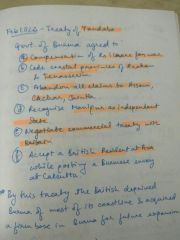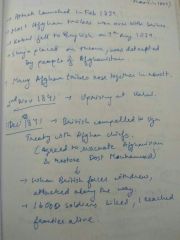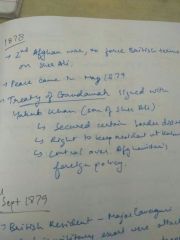![]()
![]()
![]()
Use LEFT and RIGHT arrow keys to navigate between flashcards;
Use UP and DOWN arrow keys to flip the card;
H to show hint;
A reads text to speech;
19 Cards in this Set
- Front
- Back
|
2nd Aug, 1858: Act for Betterment of India |
- abolished rule of company - abolished BoC, CoD -Established SoS who was a cabinet minister in Britain & had a council of 15 advisory members (Called India Council) - GG now called Viceroy - put an end to annexations |
|
|
India Council Act 1861 |

Enlarged Viceroy's council (1 jurist)
* at least half of legislative council had to be non officials, could be Indian or British |
|
|
Indian legislative council |

|
|
|
Provincial Administration |
3 presidencies (bombay, Madras, Bengal had more rights and power) - Governor +3 = appointed by crown - LG+ Chief Commissioners = appointed by GG |
|
|
By 1882 (policies of Lord Mayo & Lytton) |
Financial Decentralisation - 3 types of revenue 1. General 2. Provincial 3. Centre & Provinces |
|
|
Changes In Army |
1. More Europeans 2. Policy of 'Divide & Rule' or 'balance & counterpoise' (Indians given martial & non-metal status, provoked disunity) 3. Separated from Nationalist ideas |
|
|
Who were Britishers friendly with? |
- Zamindars, Landlords and Princes |
|
|
Indian Factory Acts 1881,1891 |

|
|
|
1835: freedom of Indian press |
By: Charles Metcalfe |
|
|
War with Nepal, 1814 |
Reason: British desire to extend their Indian empire to its natural geographical territory -won war -ceded districts :Garhwal, Kumaon, Tarai Areas, -withdrew from: Sikkim |
|
|
REASONS for conquest of Burma |
1. Forest resources of Burma 2. Selling British manufactured goods in Burma 3. Capture Coastal trade routes 4. Check French Influence in SE Asia |
|
|
First Anglo-Burmese War |
Reasons : Burma's expansion, border conflicts, 1+4 of last slide |
|
|
1826: Treaty of Yandabo (end of first war) |

|
|
|
2nd Burmese War |

|
|
|
1885: Third Burmese War |

|
|
|
First Afghan War (1839-1841) |

Reasons : 1. Check Russians 2. Promoting British Commercial interests in Central Asia Objective : to replace Dost mohammed by Shah Shuja |
|
|
2nd Afghan War |

|
|
|
Features of Indian Industries |
1. Most owned or controlled by British or Foreign Capital 2. Indians had a large share only in Cotton Textile industry 3. Struggle of Indian capitalists with British Banks & managing agencies 4. Government policy favouring foreign capital 5. Absence of heavy or capital goods industry 6. Growth of Plantations 7. Slow Industrial progress |
|
|
Social consequences of Industrial Development |
1. Large parts totally undeveloped as industrial growth was highly lopsided (also affecting national integration) 2. Two new social classes formed: industrial capitalist class, modern working class |

